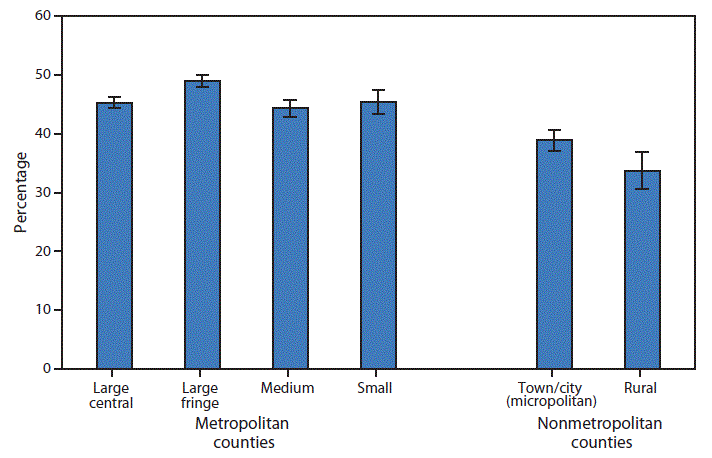QuickStats: Percentage* of U.S. Adults Who Looked up Health Information on the Internet in the Past Year,† by Type of Locality§ — National Health Interview Survey, 2012–2014¶

* With 95% confidence intervals.
† Based on sample adult's response to a question asking if, during the past 12 months, the person ever used computers to look up health information on the Internet. Responses were not limited to those who indicated that they had Internet access.
§ Counties were classified into urbanization levels based on a classification scheme developed by the National Center for Health Statistics, CDC, that considers metropolitan/nonmetropolitan status, population, and other factors.
¶ Estimates are based on household interviews of a sample of the civilian, noninstitutionalized U.S. population and are derived from the National Health Interview Survey sample adult questionnaire.
During 2012–2014, the percentage of adults aged ≥18 years who reported looking up health information on the Internet during the previous 12 months was lower among those residing in nonmetropolitan counties (33.7%–38.9%) than among those residing in metropolitan counties (44.3%–49.0%). The percentage was lowest among adult residents of rural counties (33.7%) and highest among adult residents of large fringe metropolitan counties (49.0%). Adult residents of large central, medium, and small metropolitan counties reported similar usage (44.3%–45.5%).
Sources: National Health Interview Survey. Available at http://www.cdc.gov/nchs/nhis.htm. Ingram DD, Franco SJ. NCHS urban-rural classification scheme for counties. National Center for Health Statistics. Vital Health Stat 2012;2(154).
Reported by: Deborah D. Ingram, PhD, ddingram@cdc.gov, 301-458-4733; Shilpa Bengeri.
Alternate Text: The figure above is a bar chart showing that during 2012-2014, the percentage of adults aged ≥18 years who reported looking up health information on the Internet during the previous 12 months was lower among those residing in nonmetropolitan counties (33.7%-38.9%) than among those residing in metropolitan counties (44.3%-49.0%). The percentage was lowest among adult residents of rural counties (33.7%) and highest among adult residents of large fringe metropolitan counties (49.0%). Adult residents of large central, medium, and small metropolitan counties reported similar usage (44.3%-45.5%).
Use of trade names and commercial sources is for identification only and does not imply endorsement by the U.S. Department of
Health and Human Services.
References to non-CDC sites on the Internet are
provided as a service to MMWR readers and do not constitute or imply
endorsement of these organizations or their programs by CDC or the U.S.
Department of Health and Human Services. CDC is not responsible for the content
of pages found at these sites. URL addresses listed in MMWR were current as of
the date of publication.
All MMWR HTML versions of articles are electronic conversions from typeset documents.
This conversion might result in character translation or format errors in the HTML version.
Users are referred to the electronic PDF version (http://www.cdc.gov/mmwr)
and/or the original MMWR paper copy for printable versions of official text, figures, and tables.
An original paper copy of this issue can be obtained from the Superintendent of Documents, U.S.
Government Printing Office (GPO), Washington, DC 20402-9371;
telephone: (202) 512-1800. Contact GPO for current prices.
**Questions or messages regarding errors in formatting should be addressed to
mmwrq@cdc.gov.
 ShareCompartir
ShareCompartir


